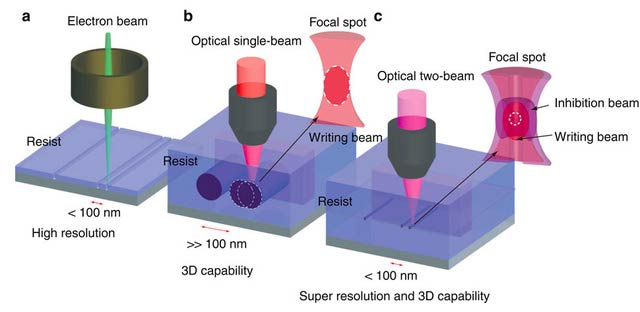Just before the weekend I read about a new technique which can be used to shoehorn around 1,000TB of data onto a ‘DVD disc’. This is quite a feat and it was achieved by circumnavigating some laws of physics with a technique which uses two different coloured light beams to selectively cancel each other out and produce a much finer beam – required for such a huge increase in data density.
Optical discs have their positive aspects, such as being cheap to produce as well as longevity and robustness but they are falling out of favour compared to other ways to back up or share data. Once thought of as an essential computer component, many people are now buying laptops that don’t include an optical disc reader or writer.

Abbe's limit
The storage capacity of a standard 12cm optical disc is limited by how small the pits burnt into its surface by a laser can be, itself limited by the diameter of the light beam doing the ‘burning’ and the reading. The upgrade from DVD to Blu-ray was down to a finer laser beam and new media which could be ‘burnt’ by that light beam.
In Physics, Abbe’s Law states that the width of light beams which can be “obtained by focussing the light through a lens, cannot be smaller than half its wavelength”. This means a visible light beam cannot be smaller than 500nm reports Phys.org. Using an optical two beam system comprised of a ‘writing beam’ and an ‘inhibitor beam’ it is possible to circumvent Abbe’s Law to create a practical laser beam that is less than 100nm in diameter, as shown in the diagram below. Phys.org says the scientists managed to achieve a laser of diameter significantly below 100nm; “This new technique produces an effective focal spot of nine nanometres – or one ten thousandth the diameter of a human hair”.

The diagram shows that the two beams are of different shapes and their overlaps cancel out to leave a much smaller focussed central light beam. Recording on the optical disc is “tightly confined to the centre” of this resulting light beam. Using this very fine laser to record on a 12cm optical disc should be able to yield capacities in the region of 1,000TB of data. This is equivalent to “10.6 years of compressed high-definition video or 50,000 full high-definition movies”.
Cost effective
The scientists say this new laser technique is “cost-effective and portable, as only conventional optical and laser elements are used, and allows for the development of optical data storage with long life and low energy consumption”. I’m looking forward to seeing this technology used in the first real-world devices which should be in “Big Data centres” according to the researchers.













